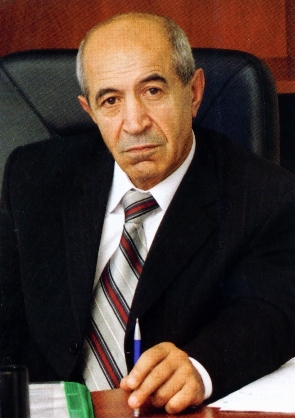
The company has begun production of unique installations that allow any enterprise to reduce their total electrical consumption by one third. But how does energy efficiency also save resources in particular, natural gas) throughout the country's energy system? Nazim Agaev, Doctor of Science (Power Engineering), Professor, Corresponding Member of IAIT, knows the answer.
Dr. Agaev is an author and the owner of an intellectual property bank of hundreds of inventions, and has developed the potential of 50 pioneering ideas in the field of environmental energy. Dr. Agaev has full confidence in the energy independence of our country.
The separation of oxygen and nitrogen, CO2 and water vapor during combustion, intensification of oxidative reactions, radiation electrolysis and hydrogen energy, vector recovery of heat emissions, vacuum thermocouples, capacitive generators without magnetic field, geothermal energy, hydro generators, light turbines, mirror and capacitive heaters, passive heat energy transformers are the main scientific arsenal of “weapons” that can protect humanity against global warming. And it is supposed to start with the simplest.
What is the mystery of the FCTF (CVI)?
With rapidly changing load (welding, metal smelting, mills, conveyors, woodworking, sawing stones, and other frequent "stop-start" processes), a certain amount of energy is required in a given period of time to complete a specific work cycle. Current pulses, in accordance with the inertia of the charge carriers, lead to voltage “dips” (flicker effect) and an even greater increase in the load current (electric drive). Active losses in the networks and the power receiver itself can be twice as high as the nominal values. The electrical system begins to “flicker” (for example, welding, adjusting, starting). The dynamic efficiency of power consumers is reduced by 3-4 times. It is during these “critical” periods of time that the FCTF provides the electrical device with electrical energy, recharging in the sinusoidal load mode, providing energy savings of up to 30-40% and completely shunting the reactive energy of the electric device.
A ubiquitous and discrete connection of the FCTF to electrical devices would result in an ideal automatic power supply system.
But FCTF (CVI) at the user end is only one of the links in the concept of “zero reactive power”. The main sources of inductive reactive energy are generators in power plants, and consumers are electric receivers with inductive resistance (transformers, electrical motors, induction furnaces, etc.). The capacity of electrical networks depends directly on the inductive resistance of the entire electrical system. Step-up, step-down, and transmission transformers consume reactive energy depending on the total amount of current. The more electrical energy that is required by enterprises, the more they consume reactive energy. The process can lead to rotating blackouts. According to the most conservative estimates, the introduction of FCTF in the entire electrical system would reduce the demands on generators by 2 or more times and/or the supply of available power can be increased without rebuilding the networks. The average return on investment (ROI) of FCTF is 1-5 years.
Dr. Agaev considers hydrogen energetics to be both practical and viable, the principal benefit being instantaneous available power. The efficiency of serial plants for the production of hydrogen and oxygen is 80%. The efficiency of well-known thermal plants (for heat generation) and thermal electric power plants ranges from 40 to 45%. Thermal stations and thermal power plants in Belarus primarily operate on natural gas, which allows the use of “dips” in instantaneous power consumption to produce hydrogen and oxygen in electrolyzers and immediately use these products for combustion, mixing them with the principal fuel. Installations for providing such a stoichiometric mixture (taking into account temperature conditions) are technically feasible. This consumption of electrical energy provides a constant optimal braking torque on the turbine shaft, stabilizing frequencies and increasing efficiency. This theoretical increase in plant efficiencies could result in savings of up to 30-40%.
However, any open combustion cycle poses a danger to the environment. Nitrogen, which makes up 78% of our atmosphere, absorbs heat energy and oxygen, and it is especially reactive at temperatures above 1200°C. All combustion creates water vapor. Over the past 50-100 years, the relative humidity of the Earth’s atmosphere, like its natural radiation background, has increased by 3-5%, which has contributed to the creation of the greenhouse effect. The water vapor content in the atmosphere is several times higher than CO2, which is also created during the conversion of biomass into oxygen. Further, the absorption spectrum of infrared radiation by water vapor (ice) is higher.
The scientific development of systems for separating oxygen and nitrogen, CO2 and water vapor in chemical combustion reactions, the recovery of thermal emissions, the development of solar and wind energy, and the use of thermal energy of the Earth offer future remedies to current challenges.
The most promising trend is, of course, the geothermal energy. From Paris to Vladivostok, the minimum temperature at a depth of 3-3.5 km is 120°C. After World War II, Belarusian scientists investigated thermal lenses in the Pripyat depression and Brest region. In some wells, at depths up to 2.5 km, the subsurface temperature reaches 180°C and higher.
At the end of the twentieth century, the Patent Office of the Republic of Belarus registered an application for a heat pipe which, without extra energy input, facilitates the “extraction” of heat energy. For 5 years, this invention was considered the best in the republic.
The heat pipe’s capacity is up to 1000 kW, using air as a coolant in a closed cycle. The cold stream entering through the inner pipe is heated along the external circuit and accelerates to the speed of sound.
Providing environmentally friendly heat and electricity to greenhouses is a fundamentally new development for agriculture in Belarus. This offers the potential for year-round production of agricultural products, prices for which will increase worldwide.
“Resource of saving is in the intellectual resource of the nation." This is Professor Agaev's firm belief.
